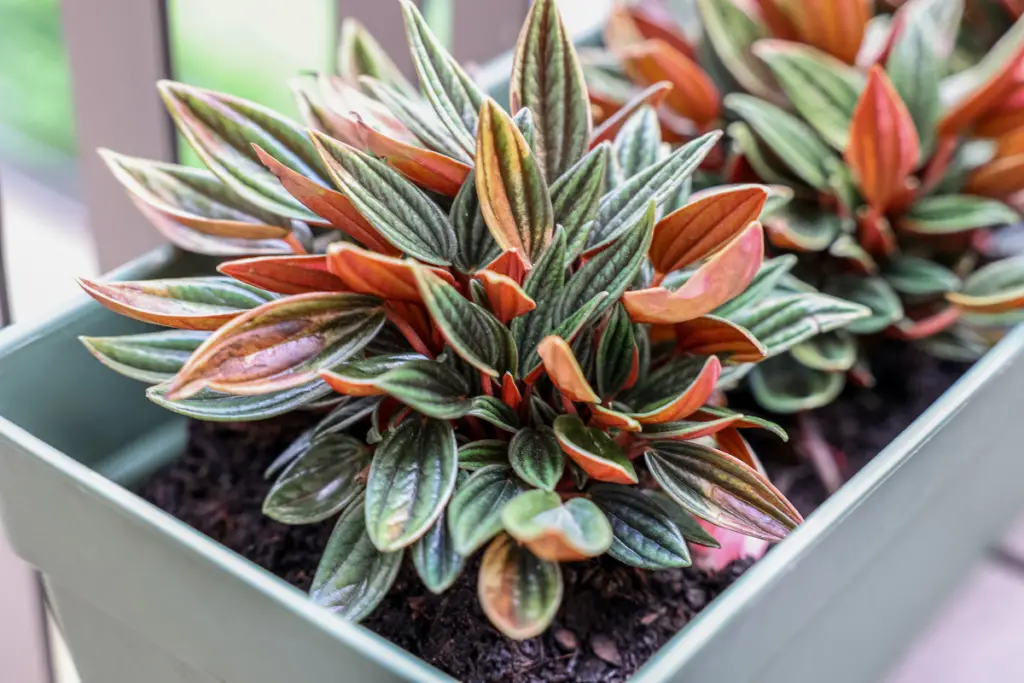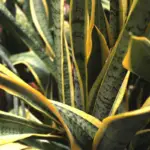Peperomia Rosso is a beautiful indoor plant that is easy to care for and adds a touch of greenery to any room.
The plant is native to South America and is known for its attractive, dark green leaves that are shaped like hearts.
Peperomia Rosso is a popular houseplant because of its low maintenance requirements and its ability to thrive in a variety of environments.
To care for Peperomia Rosso, it is important to provide it with the right growing conditions. The plant prefers bright, indirect light and can also tolerate medium indirect light.
It is important to avoid putting the plant in a low-light area as this can damage the leaves.
The soil should be well-draining to prevent soggy roots, and the plant should be watered thoroughly but allowed to dry between waterings.
Peperomia Rosso also thrives in high humidity but can do well in average humidity. By following these simple care instructions, anyone can enjoy the beauty of Peperomia Rosso in their home or office.

Table of Contents
Understanding Peperomia Rosso
Peperomia Rosso is a small, compact plant that belongs to the Peperomia family. It is a popular houseplant due to its attractive foliage and easy-care requirements.
Peperomia Rosso is also known as Radiator Plant, Emerald- or Jelly Peperomia.
The plant has thick, fleshy leaves that are dark green with a reddish tint on the underside. The leaves are oval-shaped and grow up to 2 inches long.
The plant grows up to 8 inches tall and wide, making it an ideal choice for small spaces.
Peperomia Rosso is a low-maintenance plant that thrives in average to high humidity levels. It prefers bright, indirect light but can tolerate low light conditions.
Direct sunlight can burn the leaves, so it is best to avoid it.
When it comes to watering, Peperomia Rosso likes to be kept on the drier side. Water the plant when the top inch of soil feels dry to the touch.
Overwatering can cause root rot, so it is important to ensure that the soil is well-drained. The plant also benefits from occasional misting to increase humidity levels.
Overall, Peperomia Rosso is a great choice for those looking for an easy-to-care-for houseplant with attractive foliage. With the right care, it can thrive and add a touch of greenery to any space.
Ideal Environment for Peperomia Rosso
Peperomia Rosso is a popular houseplant that is relatively easy to care for. However, to ensure that your plant thrives, it is important to provide it with an ideal environment.
This section will cover the light requirements, temperature preferences, and humidity needs of Peperomia Rosso.
Light Requirements
Peperomia Rosso does best in bright indirect light. It can tolerate partial sun or either morning or evening sun, but it cannot handle full, direct sun.
If exposed to direct sunlight, the plant’s leaves can become scorched. On the other hand, if it is kept in low light conditions, it may end up with a leggy appearance.
Fluorescent lighting is an excellent choice when growing these easy-care indoor plants.
Temperature Preferences
Peperomia Rosso prefers warm temperatures between 65°F to 80°F (18°C to 27°C). It cannot tolerate temperatures below 50°F (10°C) or above 85°F (29°C).
It is important to avoid placing the plant near drafts or vents as this can cause stress and damage to the leaves.
Humidity Needs
Peperomia Rosso prefers average to high humidity levels. If you live in a hot, desert climate, placing the plant on a pebble and water tray that adds humidity to the environment can be helpful.
However, make sure the bottom of the container stays above the water level to avoid root rot. It is also a great bathroom houseplant as it can benefit from the humidity in the air.
If the air is too dry, the plant’s leaves can become crispy and brown around the edges.
In summary, Peperomia Rosso thrives in bright indirect light, warm temperatures, and average to high humidity.
By providing the right environment, you can enjoy the beauty of this plant for years to come.
Watering Rosso Peperomia
Watering Rosso Peperomia can be tricky as the soil must dry out a bit between waterings. The plant dislikes soggy soil, but cannot survive an extended drought.
It’s essential to strike a balance between overwatering and underwatering.
To water Rosso Peperomia, stick your index finger into the soil at least 2 inches deep. If the soil already feels dry, it’s time to water the plant.
Water thoroughly, until excess water flows from the drainage hole into the saucer, but do not allow the plant to sit in excess water or soggy soil.
If you prefer to adhere to a schedule, watering Rosso Peperomia should happen once every 10 days or so. However, it’s best to rely on the soil’s moisture level to determine when to water the plant.
It’s also important to note that Rosso Peperomia is similar to a succulent in that it stores water in its leaves and can tolerate drying out a bit between waterings.
Overwatering can cause root rot, which can be fatal to the plant.
In summary, water Rosso Peperomia when the soil is about 50-75% dry. Water thoroughly, until excess water flows from the drainage hole into the saucer, but do not allow the plant to sit in excess water or soggy soil.
Rely on the soil’s moisture level to determine when to water the plant, and avoid overwatering to prevent root rot.
Soil and Fertilizer Requirements
Soil Type
Peperomia Rosso prefers soil that is well-draining and holds moisture. When selecting soil, it is best to use potting soil that drains well while still holding some moisture.
A mixture of peat moss, perlite, and vermiculite is ideal for growing Peperomia Rosso. It is important to avoid using heavy soils that do not drain well, as this can lead to root rot.
Fertilizer Needs
Peperomia Rosso plants benefit from regular fertilization during the growing season. Fertilize once a month with a balanced liquid houseplant fertilizer at 1/2 strength.
It is important to avoid over-fertilizing, as this can lead to fertilizer burn and damage the plant.
It is also important to note that Peperomia Rosso is sensitive to salt buildup in the soil, which can occur when using fertilizers.
To prevent salt buildup, it is recommended to flush the soil with water once a month to remove any excess salts.
Overall, Peperomia Rosso can be a tricky plant to care for. While it is not an extremely high maintenance plant, it does require specific soil and fertilizer conditions to thrive.
By following the soil and fertilizer requirements outlined above, growers can ensure that their Peperomia Rosso plants remain healthy and vibrant.
Propagation Techniques
Peperomia Rosso is an easy-to-care-for plant that can be propagated from both leaf and stem cuttings. Here are the two most common propagation techniques:
Leaf Cutting
Leaf cutting is the easiest way to propagate Peperomia Rosso. Select a healthy leaf from the plant and cut it off with a sharp, clean knife or scissors.
Make sure the leaf is at least 2 inches long and has a stem attached to it. Remove the bottom leaves from the stem and dip the cut end into rooting hormone powder.
Then, insert the stem into a pot filled with moist potting soil. Cover the pot with a plastic bag to create a humid environment. Keep the soil moist and place the pot in a bright, indirect light.
After a few weeks, the leaf should start to grow roots and a new plant will begin to emerge.
Stem Cutting
Stem cutting is another way to propagate Peperomia Rosso. Choose a healthy stem with a few leaves attached to it and cut it off with a clean, sharp knife or scissors.
Make sure the stem is at least 2 inches long and has a few leaves attached to it. Remove the bottom leaves from the stem and dip the cut end into rooting hormone powder.
Then, insert the stem into a pot filled with moist potting soil. Cover the pot with a plastic bag to create a humid environment.
Keep the soil moist and place the pot in a bright, indirect light. After a few weeks, the stem should start to grow roots and a new plant will begin to emerge.
Propagation is a great way to expand your collection of Peperomia Rosso plants. With the right care and attention, your new plants will thrive and add color and texture to any space.
Pruning and Repotting Rosso Peperomia
Peperomia Rosso is a fast-growing plant that can quickly become leggy and unattractive if left unpruned. Pruning is an essential part of caring for this plant.
It helps to maintain its shape, control its size, and encourage bushier growth. Pruning should be done in the spring or early summer when the plant is actively growing.
To prune Peperomia Rosso, use a clean, sharp pair of scissors or pruning shears. Cut the stem just above a leaf node or where it meets another stem.
This will encourage new growth from the node, and the plant will become bushier. It’s also a good idea to remove any yellow or dead leaves to keep the plant looking healthy.
Repotting Peperomia Rosso is necessary when the plant has outgrown its current container or when the soil has become compacted and doesn’t drain well.
Repotting should be done in the spring or early summer when the plant is actively growing.
When repotting, choose a pot that is one size larger than the current pot and has drainage holes. Fill the bottom of the pot with a layer of gravel or broken pottery to improve drainage.
Use a well-draining potting mix that is rich in organic matter. Gently remove the plant from its current pot and loosen the roots.
Place the plant in the new pot and fill in the gaps with potting mix. Water the plant thoroughly and place it in a bright, indirect light.
Peperomia Rosso can be propagated easily by stem cuttings. Take a stem cutting in the spring or early summer and remove the bottom leaves.
Dip the cut end in rooting hormone and plant it in a small pot filled with moist potting mix. Place the pot in a bright, indirect light and keep the soil moist.
The cutting should root in a few weeks, and you can transplant it into a larger pot once it has established roots.
Common Problems and Solutions
Peperomia Rosso is generally a low-maintenance plant, but it can still encounter some problems. Here are some common issues and their solutions:
Overwatering
Overwatering is the most common problem with Peperomia Rosso. When the plant is overwatered, the soil becomes waterlogged, which can lead to root rot.
Signs of overwatering include yellowing leaves, wilting, and a mushy stem. To fix the problem, stop watering the plant and let the soil dry out completely.
If the roots are already affected, remove the plant from the pot and trim off any damaged roots. Repot the plant in fresh soil and water it sparingly.
Pest Infestation
Peperomia Rosso is relatively pest-resistant, but it can still attract pests like mealybugs, spider mites, and scale insects.
These pests can cause damage to the leaves and stems, leading to stunted growth and discoloration.
To prevent pest infestation, keep the plant in a clean and well-ventilated area. If you notice any pests, remove them manually or use an insecticidal soap to get rid of them.
Disease Issues
Peperomia Rosso is susceptible to fungal and bacterial diseases, especially if the plant is overwatered or exposed to high humidity.
Symptoms of disease include yellowing leaves, black spots, and a mushy stem. To prevent disease, make sure the plant is not overwatered and is kept in a well-ventilated area.
If the plant does get diseased, remove the affected parts and treat the plant with a fungicide or bactericide.
Overall, with proper care and attention, Peperomia Rosso can thrive and add a touch of greenery to any indoor space.
Conclusion
Peperomia Rosso is a beautiful and easy-to-care-for plant that is perfect for anyone looking to add a touch of green to their home or office. With its unique red and green leaves, this plant is sure to be a conversation starter.
To ensure that your Peperomia Rosso thrives, make sure to provide it with the right growing conditions.
This includes placing it in a well-draining soil mix that contains peat moss or perlite, and watering it when the top half of the soil has dried out.
Peperomia Rosso also prefers bright, indirect light, but can tolerate low light conditions. You can also fertilize it once a month during the growing season to encourage healthy growth.
Overall, Peperomia Rosso is a low-maintenance plant that is perfect for beginners and experienced plant owners alike.
With its unique look and easy care requirements, it’s no wonder why this plant is becoming increasingly popular.
- How to Dry Basil Leaves: A Professional Guide
- Is an Avocado a Fruit or Vegetable? Simple Answer and Explanation
- Does Pineapple Have Seeds? Exploring the Anatomy of Pineapples
- Blooming Through Winter: Can I Grow Vegetables Indoors in the Winter?
- What Can You Grow in a Greenhouse All Year Round: A Guide to Year-Round Greenhouse Gardening
- Are Blueberries Blue? Debunking the Myth of Their Color
















